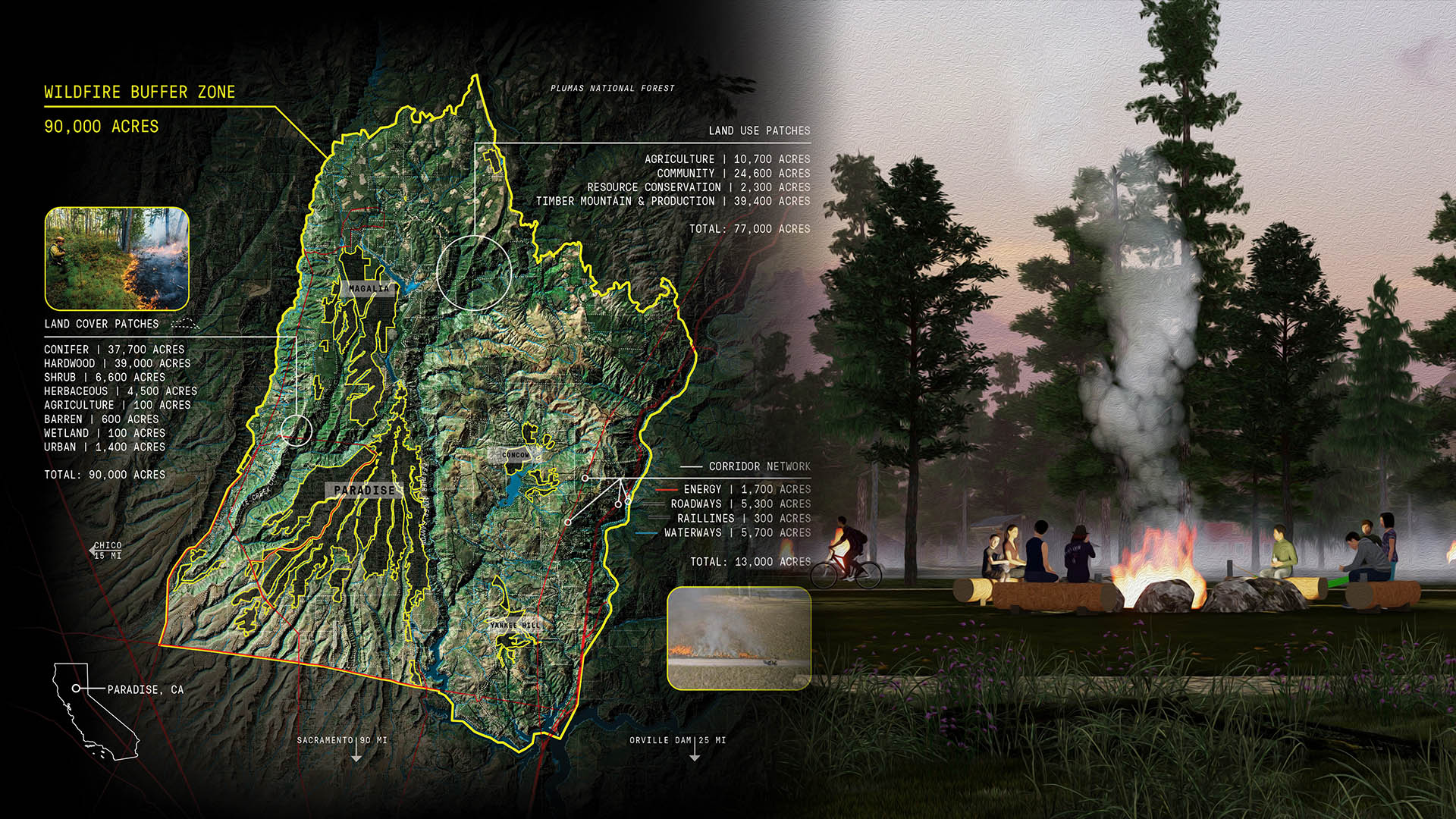SWA’s “Edge of Paradise”
Winner, Urban Design Category: World Changing Ideas Award, Fast Company

The Edge of Paradise: Applied Research into wildfire mitigation strategies that pairs technical analysis with illustrative communication.

Jonah Susskind
Senior Research Associate

Alison Ecker
Project Planner & Designer
A Cool Approach to a Hot Topic
Fast Company announced its 2022 Winners of its World Changing Ideas Award, which honors clean technology, innovative corporate initiatives and brave new designs for cities and buildings and other creative works tackling social innovation, social inequality, climate change, and public health crises.
Winner of the Urban Design category (and an honorable mention in the Climate category), SWA’s Edge of Paradise was one of 39 winners selected by a panel of eminent Fast Company editors and reporters from a pool of nearly 3,000 entries world-wide.
The project examines the Town of Paradise, California, which was destroyed by fire in 2018, as a case study for mitigating risk and increasing resilience for fire prone rural communities. It pioneers community-scaled design strategies and offers an illustrative approach to help communities communicate and adopt those strategies.
Drawing heavily from landscape ecology and indigenous principles of prescribed fire management, the project proposes a series of implementable wildfire resilience strategies in a contiguous 90,000-acre buffer zone. These strategies propose to reduce wildlands fuels while simultaneously offering the co-benefits of high-value agricultural production, renewable energy, and recreational programming.
The strategies are scalable and transferable, enabling landscape architects and urban designers to effectively respond to the growing crisis of wildfire under the dual pressures of climate change and accelerated urbanization, a ground-breaking approach to one of the most significant resilience challenges of our time.
We asked SWA associates Jonah Susskind and Alison Ecker, principal authors, to share more about the project, including a video of the project’s highlights.
Why is it important?
Jonah:
The project advances the idea of defensible space at the scale of an entire community.
In wildfire-prone regions, designing and maintaining “defensible space” is a well-known practice at the scale of individual parcels. Essentially this means that combustible materials and flammable vegetation are cleared from the area immediately around structures, and that certain vegetation management guidelines are followed further out (typically in designated zones between 5 and 100 feet from the edge of the building).
This project scales up this idea of “defensible space” to the size of the whole community by ensuring that lower-risk land uses are maintained between developed areas and undeveloped wildlands. From an ecological perspective, thinking at this scale also allows designers to influence systems such as seasonal water availability, plant succession, wildlife habitat, and patch dynamics.
It reinforces the importance of landscape and urban design decisions in reducing the risk of wildfire in the Wildlife Urban interface (WUI) where nearly 25% of the population resides in California.
What’s the genesis of this project?
Jonah: A bunch of streams came together. I worked on this topic of wildfire resilience while teaching at MIT’s Department of Urban Studies and Planning. I was studying urban development patterns in California and their relationship to environmental risks including wildfire.
Alison: The firm is also increasingly working on development projects in California where wildfire is a significant challenge for clients, and we are seeking solutions minimize risk. The Landscape Architecture Forum sponsorship of the Green New Deal Super Studio, an ideas competition, offered an avenue to that explore how the profession could advance creative wildfire strategies in practice.
Jonah: We decided to partner up and approach the topic together. Around the same time, we noticed that the Town of Paradise was collaborating on their rebuilding effort with some partners, so we reached out to them directly to see if we could work with them, pro-bono, to examine solutions at the community scale.
What did the Town of Paradise find helpful?
Jonah: After such a traumatic experience, it can be extremely hard for a community to open themselves up to new ideas. There is a natural urge to want to rebuild just as things were before the fire.
In addition to the technical analysis we were doing, we also created illustrative drawings that helped residents “see” what the future community and its surrounding landscape might look like. The point was for people to understand that managing vegetation at a large scale can produce landscapes that are less vulnerable to catastrophic fire and still feel robust, healthy and beautiful. This enabled the community to be focused on the future rather than on loss and hardship.
What’s the impact of this approach beyond Paradise?
Jonah: There are so many people who live in fire-prone landscapes, particularly in California– nearly 25% of the state’s population. As the housing crisis deepens, development is forced further from uban cores and into landscapes where fire risk is highest. This increasingly includes suburban communities.
Our method is flexible. It uses GIS to draw on local and regional databases, and enables us to generate site- or community-specific strategies to mitigate risk and take advantage of other benefits—such as increasing recreation, biodiversity, timber yields—of implementing them.
Alison:
The project also gave us the space and time to think creatively about possible wildfire solutions and dig deeper into the existing research. Our discovery in this project has helped us to rethink and improve some of our wildfire approaches on real, ongoing, client-based master planning projects throughout California.
This project—along with our client work—inspired the firm to focus its annual summer student program on the ongoing wildfire crisis in California for the 2022 session. For the past 50 years, this program has gathered emerging designers to explore critical contemporary design questions. Many participants have become leaders within the firm and the discipline. Themed “California Burning”, this year’s summer studio will gather eight top graduate students in our Sausalito studio to explore and expand our growing catalog of wildfire design strategies for a site in nearby Sonoma County.
Curious about the project? Check out the video or read more here.

